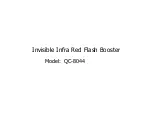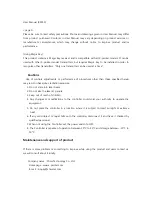
IL3 User’s Guide
page 62
11S-3002B
Application Note 2: Understanding Bit Depth
Each pixel in a digital image has a numeric value. Low numbers represent dark pixels; higher numbers
represent brighter ones.
Mono images that we see displayed on computer screens use 256 shades of gray. The pixel values
range from 0 to 255. Color images use 256 shades each of red green and blue. With 256 (red) x 256
(green) x 256 (blue), color images may use more than 16 million colors!
The TS3 sensor outputs 10-bit image data. This represents 1024 shades of gray for mono, and 1024
shades each for Red, Green, and Blue for color-- that would be 1024
3
... over a billion colors!
Decimal numbers 0 to 1023 are expressed 0000000000 to 1111111111 in binary. Each binary digit is a
“bit.” So a 3 bit number, 000 to 111, is the equivalent to decimal 0 to 7. An 8-bit number, 00000000 to
11111111, is the equivalent to decimal 0 to 255. A 10-bit number is equivalent to decimal 0 to 1023.
Because we will be accessing the imagery on devices such as computers and LCD screens like the one
on the TS3, that can only display 256 shades of gray (or 256
3
colors) one valid option is to save only 8
of the 10 bits produced for each pixel of the sensor. If we choose this option, we will need to decide
which 8 of the 10 bits to save. There are three choices:
1. High 8-bit
(dropping the two least significant bits and saving the high-order bits):
11111111
11
In this case we have a mapping that looks like this:
10-bit (1024) values (in decimal): 0 1 2 3 4 5 6 7 8 9 10 11 .................511.............................1023
8-bit (256) values (in decimal): 0 0 0 0 1 1 1 1 2 2 2 2 ...................127...............................255
Note that for the 10-bit image 0 is black 511 is midway to saturation (white) and 1023 is at saturation.
For the 8-bit image 0 is black, 127 is midrange and 255 is white--the two images would appear the
same to us.
2. Mid 8-bit
(dropping the least significant bit and the most significant bit, saving the Mid-order bits):
1
11111111
1
In this case the mapping looks like this:
10-bit (1024) values: 0 1 2 3 4 5 6 7 8 9 10 11.........255..................511...........................................1023
8-bit (255) values: 0 0 1 1 2 2 3 3 4 4 5 5...........127..................255
Note that while we have the same starting point (black = 0), saturation now comes at the midrange
of the original 10-bit data. Compared with the High 8-bit mapping, this image has twice as steep
a response slope--it is much brighter. This brightness will come at the cost of seeing more noise,
however.
3. Low 8-bit
order bits (dropping the two most significant bits and saving the lower 8):
11
11111111
10-bit (1024) values: 0 1 2 3 4 5 6 7 8 9 10 11...........255............512................................................1023
8-bit (255) values: 0 1 2 3 4 5 6 7 8 9 10 11...... ....255
As with the other mappings, black is black = 0, but with the Low 8-bit mapping, saturation comes
twice as fast as with the Mid 8-bit and 4x as fast as with the High 8-bit.
Содержание IL3
Страница 1: ...IL3TM High Speed Camera Operator s Manual 2013 9 110S 3002B...
Страница 71: ...IL3 User s Guide 11S 3002B page 63 Figure 7 4 High Mid and Low 8 Bits of the same Image...
Страница 102: ...IL3 User s Guide page 94 11S 3002B Appendix J Physical Measurements Figure 8 10 Physical Measurements...
















































